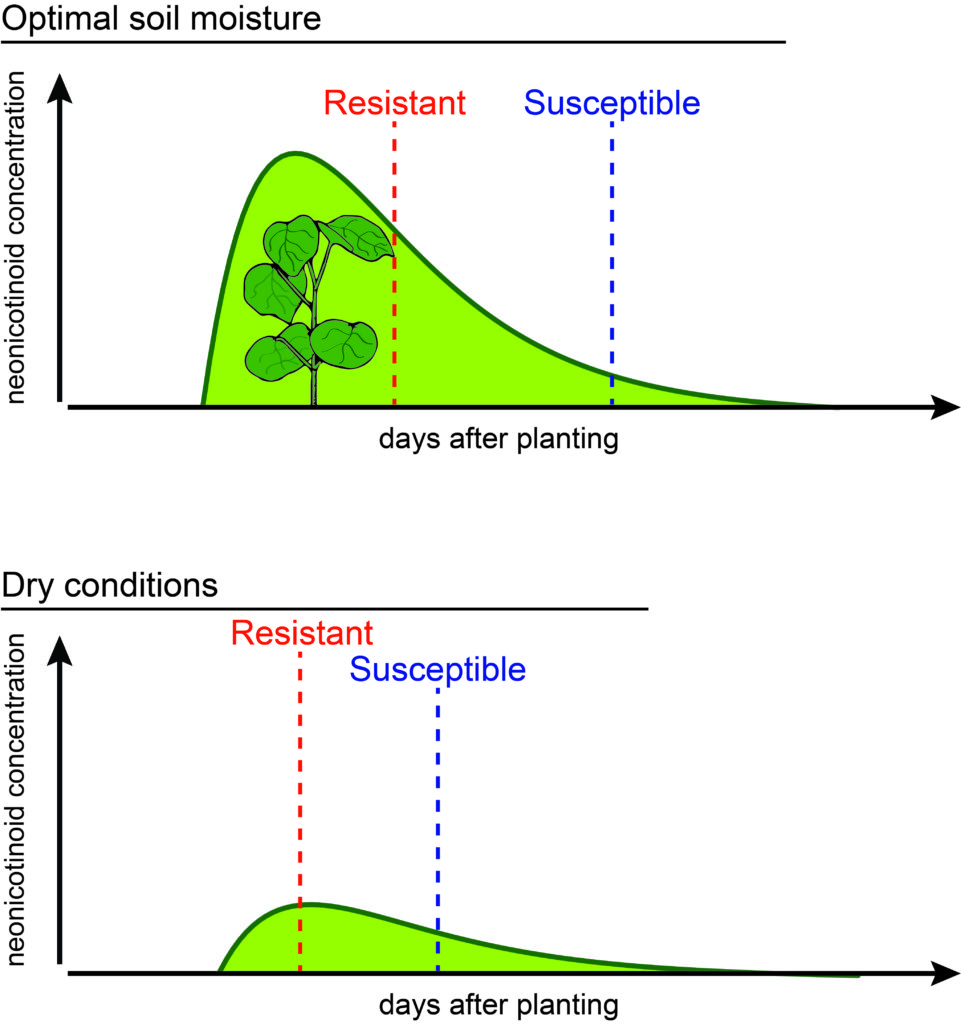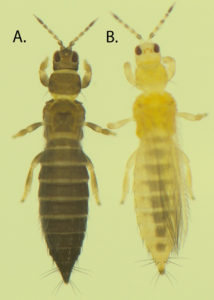Update on Thrips Damage in Cotton: Insecticide Resistance or Reduced Neonicotinoid Protection? (Huseth, Reisig, Collins)
go.ncsu.edu/readext?603570
en Español / em Português
El inglés es el idioma de control de esta página. En la medida en que haya algún conflicto entre la traducción al inglés y la traducción, el inglés prevalece.
Al hacer clic en el enlace de traducción se activa un servicio de traducción gratuito para convertir la página al español. Al igual que con cualquier traducción por Internet, la conversión no es sensible al contexto y puede que no traduzca el texto en su significado original. NC State Extension no garantiza la exactitud del texto traducido. Por favor, tenga en cuenta que algunas aplicaciones y/o servicios pueden no funcionar como se espera cuando se traducen.
Português
Inglês é o idioma de controle desta página. Na medida que haja algum conflito entre o texto original em Inglês e a tradução, o Inglês prevalece.
Ao clicar no link de tradução, um serviço gratuito de tradução será ativado para converter a página para o Português. Como em qualquer tradução pela internet, a conversão não é sensivel ao contexto e pode não ocorrer a tradução para o significado orginal. O serviço de Extensão da Carolina do Norte (NC State Extension) não garante a exatidão do texto traduzido. Por favor, observe que algumas funções ou serviços podem não funcionar como esperado após a tradução.
English
English is the controlling language of this page. To the extent there is any conflict between the English text and the translation, English controls.
Clicking on the translation link activates a free translation service to convert the page to Spanish. As with any Internet translation, the conversion is not context-sensitive and may not translate the text to its original meaning. NC State Extension does not guarantee the accuracy of the translated text. Please note that some applications and/or services may not function as expected when translated.
Collapse ▲Reports of thrips damage on cotton with an insecticidal seed treatment and/or in-furrow neonicotinoid (Admire Pro) have increased over the past week. Concern about thrips resistance to neonicotinoid insecticides (the active ingredient in Admire Pro and insecticidal seed treatments) has generated lots of questions about managing damage on susceptible cotton. Here, we will unpack the situation and provide recommendations to reduce risk for thrips damage in 2019.
Weather conditions driving thrips populations: With several rain-free weeks of good weather, the majority of cotton in North Carolina has been planted. However, excellent weather also benefits thrips populations that are developing in non-crop weeds, cover crop rye, and other small grains. A seven-county survey of grains throughout the eastern production region detected an uptick in adult and larval tobacco thrips populations last week (5/13/19-5/17/19). We anticipate these populations will continue to grow and eventually move into cotton as the non-crop weeds and wheat begin to dry down.
Soil moisture, organic matter, and insecticide uptake: The neonicotinoid insecticides used as an in-furrow or seed treatments in cotton are water-soluble compounds that are taken up through the roots and translocated into growing leaf tissues above ground. While the absorption and distribution of different neonicotinoids can vary, we do know that very dry conditions can affect uptake of some materials. In soybean, moisture stress negatively affected clothianidin (active ingredient in Acceleron and Poncho for corn) uptake but not imidacloprid (active ingredient in Acceleron Standard and Elite, Aeris, and Admire Pro for soybeans and cotton) under laboratory conditions.1 In cotton this relationship is not well understood, however, field studies have shown that neonicotinoid concentrations in cotton leaves do vary over time and across years.2 This process is likely driven by weather conditions that affect insecticide movement in the plant.
Organic matter in the soil can also affect the absorption and movement of neonicotinoids. Soils that are high in organic matter tend to bind up neonicotinoid insecticides, thereby reducing the portion of insecticide available to the plant. Soil binding properties are one reason in-furrow applications of neonicotinoids can be less successful than traditional seed treatments when soil organic matter is high.
As a result, the concentration of insecticide in the leaf tissue may be different under moisture stress or high organic conditions when compared to the same seedling grown under optimal soil moisture conditions (field capacity) on a mineral soil. Under marginal conditions, some insecticide will be present in the leaves; however, the concentration may not be high enough to kill immature thrips.
Interactions between insecticide uptake and neonicotinoid resistant thrips: Understanding the interaction between insecticide resistance and concentration of insecticide in the plant can be challenging when diagnosing a problem in the field since it changes over time and environment (soil, weather, moisture, etc.). There are two key factors that influence damage in cotton treated with insecticide for thrips: 1) the amount of insecticide required to kill resistant thrips vs susceptible thrips and, 2) the amount of insecticide in the plant over time. To predict efficacy, we need to understand the interaction between these factors (Figure 1). In the example given in the figure, we might see either resistant and susceptible thrips populations establish when conditions are not favorable for insecticide uptake into growing seedlings due to dry conditions.

Figure 1. Hypothetical relationship between growing conditions and neonicotinoid resistance status of thrips. Under optimal conditions, resistant thrips can establish on seedlings with higher concentrations (dashed lines indicate establishment and reproduction). Lower insecticide concentrations favor the establishment of both susceptible and resistant populations.
Together, resistance and growing conditions can combine to affect the duration of neonicotinoid protection in any given field. Here, geography can really matter. What kind of thrips population surrounds your field? Has there been an issue with neonicotinoids in the past? If so, are growing conditions very dry? If the answer to these two questions is yes, you may consider a timely preventative application of a foliar insecticide to limit development of immature thrips (preferably at or before first true leaf).
Recommended management strategies for the next two weeks: Over the next few weeks, protection of susceptible cotton will be very important. Given the warm conditions, seedlings should grow through the four to five true leaf thrips susceptibility window quickly. However, if dry conditions persist and plant development slows, preventative control measures may be necessary. We recommend protective treatments of acephate (4 oz) or Radiant (3 oz or more) on susceptible cotton at cotyledon or first true leaf stage. Once the cotton has exited the susceptibility window (past 5 leaves), foliar applications will have limited benefit to reduce damage caused by thrips. Also, note that there is more bang for the buck when sprays are applied earlier in the susceptibility window. Because the susceptibility of cotton seedlings can vary in time, looking back at how insecticides performed in specific fields is one way to understand damage risk. The Thrips Infestation Predictor can be a useful way to understand which planting dates are at the greatest risk for damage.

Figure 2. Tobacco thrips (Frankliniella fusca Hinds) (A) and western flower thrips (Frankliniella occidentalis Pergrande) (B).
Western flower thrips infestations are typically spotty this early in the season, and they are rarer in North Carolina compared to other places in the Cotton Belt; however, they can occur in North Carolina cotton, especially when conditions are hot and dry. Understanding which thrips species is in the field can be crucial when choosing the appropriate insecticide since western flower thrips are harder to control. Western flower thrips adults are typically light brown and highly mobile when disturbed. In contrast, female tobacco thrips are dark black and are not as active. Adult thrips can be counted directly on seedlings or by striking seedlings on a piece of white printer paper. Note that larval thrips of species in cotton are also light colored, but will not have wings. While there is not a specific adult threshold to trigger a spray, we do recommend that growers choose Radiant (3 oz or more) over acephate if western flower thrips are present in large numbers.
Navigate to the Thrips Infestation Predictor.
Navigate to an earlier post on thrips control decisions.
References
- Stamm, M. D., Heng‐Moss, T. M., Baxendale, F. P., Siegfried, B. D., Blankenship, E. E., & Nauen, R. (2016). Uptake and translocation of imidacloprid, clothianidin, and flupyradifurone in seed‐treated soybeans. Pest management science, 72(6), 1099-1109.
- Zhang, Z., Zhang, X., Wang, Y., Zhao, Y., Lin, J., Liu, F., & Mu, W. (2016). Nitenpyram, dinotefuran, and thiamethoxam used as seed treatments act as efficient controls against Aphis gossypii via high residues in cotton leaves. Journal of agricultural and food chemistry, 64(49), 9276-9285.


